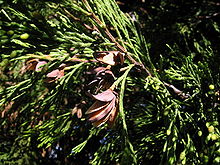Incense Cedar
| Incense-cedar | |
|---|---|
 |
|
|
Calocedrus decurrens California incense cedar |
|
| Scientific classification | |
| Kingdom: | Plantae |
| Division: | Pinophyta |
| Class: | Pinopsida |
| Order: | Pinales |
| Family: | Cupressaceae |
| Genus: |
Calocedrus Kurz |
| Synonyms | |
|
Heyderia K.Koch, illegitimate homonym |
|
Heyderia K.Koch, illegitimate homonym
Calocedrus (common name incense cedar, alternatively spelled incense-cedar) is a genus of coniferous trees in the cypress family Cupressaceae first described as a genus in 1873. It is native to eastern Asia and western North America. The generic name means "beautiful cedar".
The genus is related to the Thuja, and has similar overlapping scale-leaves. Calocedrus differs from Thuja in the scale leaves being in apparent whorls of four (actually opposite decussate pairs like Thuja, but not evenly spaced apart as in Thuja, instead with the successive pairs closely then distantly spaced), and in the cones having just 2–3 pairs of moderately thin, erect scales, rather than 4–6 pairs of very thin scales in Thuja.
Calocedrus decurrens, California incense cedar (syn. Libocedrus decurrens), is native to western North America. It is a large tree, typically reaching heights of 40–60 m and a trunk diameter of up to 3 m (maxima, 69 m tall and 3.9 m diameter), and with a broad conic crown of spreading branches. The leaves are bright green on both sides of the shoots, and the cones 2–2.5 cm long. It is by far the most widely known species in the genus, and is often simply called "incense cedar" without the regional qualifier.
Calocedrus formosana, Taiwan incense cedar, is endemic to Taiwan. It is very similar to C. macrolepis, and some botanists treat it as a variety of that, C. macrolepis var. formosana. It is a medium-sized tree, growing to 25–30 m tall, and is rare in the wild, occurring only as scattered trees in mixed forests. The leaves are glaucous green on the upper side of the shoots, and conspicuously marked with bright white stomatal patches on the underside. The cones are 1.5–2 cm long, carried on a 1–1.5 cm stem.
†Calocedrus huashanensis is an extinct species which was described in 2012. It is known from compression fossils found in the Oligocene age Ningming Formation of southern China. Calocedrus huashanensis is known from branches and leaves.
...
Wikipedia
